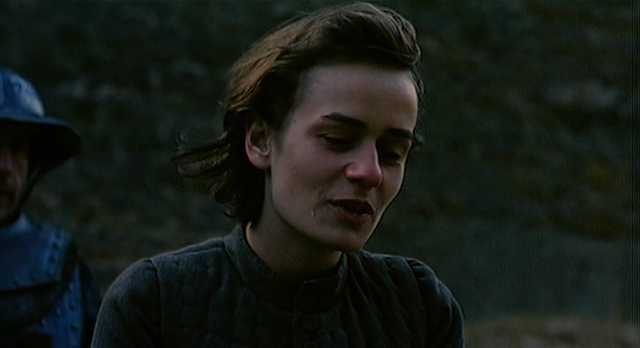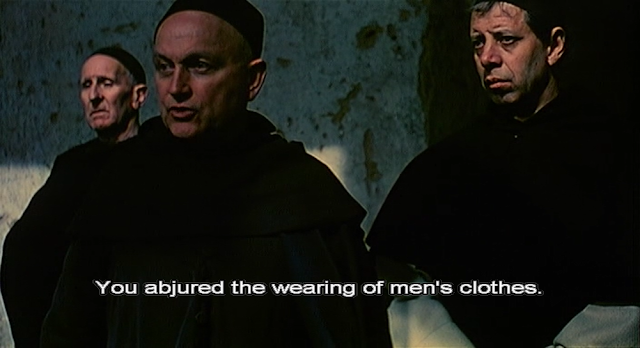*Analysis of a scene is a feature on Curtsies and Hand Grenades where I take a look at specific scenes in movies and discuss them*
Jacques Rivette smartly evades the weight of Carl Th. Dreyer’s The Passion of Joan of Arc by never trying to emulate or tap into the same filmmaking techniques that bluntly created one of the most devastating portraits of personhood in all of Cinema. Dreyer focused on the weary, crumbling presence of Maria Falconetti’s face in close-up, but Rivette’s picture avoids those comparisons by never actually focusing on the trial or lingering on the tragedy. Instead, Rivette opts for a portrait of Joan as a person who was persecuted not only because she was considered an idolatress, but because she dared call into question the place of women in society by subverting her gender role and dabbling in masculine presentation.
Joan giddily darts a pair of scissors across her unkempt straw-like hair in order to please god and herself. She chooses a mirror of armour, a masculinizing of vanity. Her reflection reveals an evolving self. In order for Joan to go into battle she must adopt the roles of men. If she is going to be with the men she must be a man. Her first task is to remove the long hair that paints her as feminine. She mutters to another woman who works nearby that she must look like a boy, and in an attempt to make her haircut more appropriate the woman offers to even up her look. This early scene paints a portrait that continues throughout the rest of the film, and it is one of women helping Joan achieve her goals. Whether those women know that Joan is only merely doing these things because she sees messengers of god or they envision a woman breaking barriers of gendered norms is irrelevant. They help her regardless. The same woman who cuts her hair finds her a suit of armour made from hand-me-downs of smaller boys.
Jacques Rivette shoots his adaptation of Joan of Arc with documentary style realism. There are insertions of talking head shots to deliver the exposition of the narrative. These scenes are coupled with recreations of the events certain characters discussed moments previously, and the majority of the first act is Joan’s acceptance of her task and the battles she wins for her country and for God. Along the way many men question the legitimacy of Joan’s combat and military skill, often chalking any setbacks to her gender, and whenever she succeeds men say “I’ve never seen a woman do that before” or “You’re pretty good for a woman”, to paraphrase. These exchanges of soldiers finding their notions of gender challenged further establish a theme on Joan’s breaking of binary ideas on what a woman can or cannot accomplish. Even a woman can die for her country, and her beliefs.
This particular version of Joan’s story is split into two parts and while the first film is relatively triumphant the second part brings about the inevitable tragedy that is nestled inside of this story. The tranquil pace of the first picture begins to evolve in the final hours, as that same pacing mutates from peaceful to brutally anxious. Every viewer goes into the film knowing that Joan is a martyr, but Rivette alters this narrative slightly, and presents a wrinkle on Joan’s doom that is far more powerful in day to day life than the religious persecution that colours Dreyer’s masterpiece. In Rivette’s film her martyrdom would be one of the illusion of choice for a woman who lives in an uncaring patriarchal environment.
Once Joan is captured by the English they begin a trial based around her idolatry, which Rivette only briefly engages, but the reasoning behind the trial is clearly the deep-seated misogyny behind the men who would be furious that a woman defeat them in a battle. If battle is not man’s sport anymore then what does he have left to conquer? But it’s more than that as well. There is a hatred in how easily Joan was able to try on a masculine identity, and worse how natural a fit it became on her body. The bible states in Deuteronomy that any man or woman who would wear the clothing that wasn’t associated with their gender would be considered an abomination, a disgusting thing, a wicked creature. Joan came through God, but was challenging the very notions of his perceived word. There would be no evolving of ideas on a gender binary. There would only be fire to put out an idea.
That idea would spread in subtle ways. In one digression a mother is frustrated her daughter’s hair is tangled. The girl doesn’t want to straighten or comb her hair, and after spending a short amount of time with Joan she seems to have grasped towards that freedom Joan was exhibiting in her presentation, even if that just meant letting her hair become slightly messy. This one scene is the fissure in society caused by Joan’s gendered rebellion, and in a cinematic context it is all the evidence one would need to know Joan was causing change in the ideas of the women around her. Maybe I didn’t have to spend so much time on my appearance?
Joan took the dress under the condition that she would be sent back to a prison in her home country and if she would be given female prison guards to attend to her needs. That final detail is important, because Joan knew that women, in this telling of the story, would have her back. Throughout this film women have been helping her along the way, whether that be the woman who helped her find the armour or the girl she befriended before trial. They were Joan’s true angels. When the prison guards rip her of her masculinity and force her back into the more traditional femininity that she was seen wearing in the first scenes of the film it spells her doom. As a prisoner she was left to the will of the men around her, because there would be no female prison guards. Only men who saw a vulnerable woman who they could have their way with on repeated occasions. They wrap her in chains. Her dress exposed. A metaphor for the place women held in society during Joan’s period of life. The only way to push back the rapist prison guards was to dress like a man again after they loosened her shackles. It was the only protection she had against rape. And as soon as they saw she was dressing this way again the priests decided she had rebuked god, but they weren’t acting in the law of god. They were acting in the law of man. The law of man that would say a woman should stay in her place and lest she get out of line she be put back where she belonged. For Joan that meant ash.
































Be First to Comment